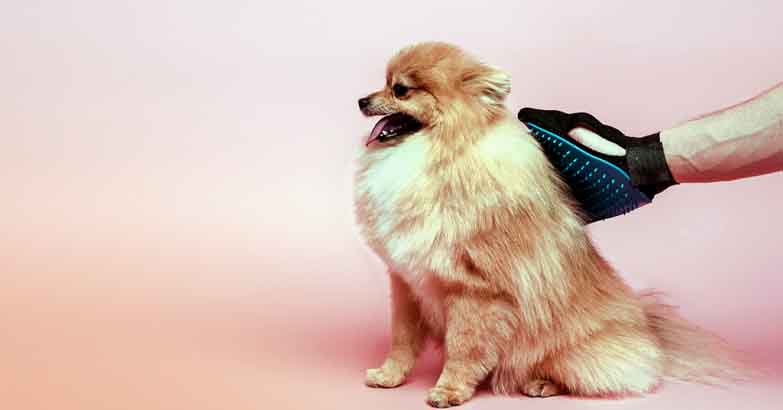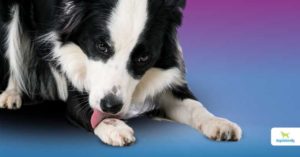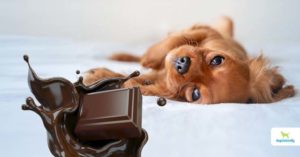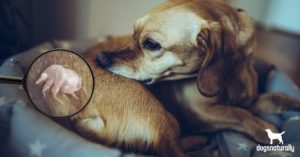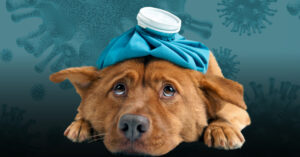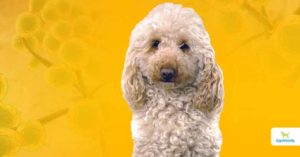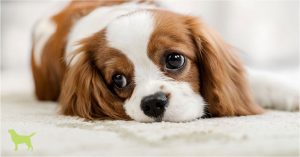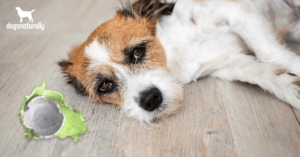If you’re seeing white flakes on your dog’s coat, it’s probably dog dandruff. It’s usually nothing to worry about and the good news is that it is easily treatable.
So let’s look into dog dandruff and explore its causes, potential harm and how diet and natural methods can restore your dog’s skin and coat to a healthy condition.
What Is Dog Dandruff?
Dog dandruff is flaky skin on a dog’s coat. It looks like dry skin, but in fact skin with dandruff may be either dry or oily. You’ll be able to see dandruff on your dog’s coat and even on your his bedding. You might also see a dull or greasy coat, itchiness or redness on the skin.
Can Dog Dandruff Be Harmful?
In most cases, dog dandruff is not harmful to your dog’s overall health. More than anything, it’s a warning sign that you need to improve a few things like his diet … and make sure there’s deeper cause or health condition.
Dog dandruff can cause discomfort, itching and irritation, leading to excessive scratching, hair loss, or skin infections if you don’t address it.
Why Does My Dog Have Dandruff?
Dry skin is the main cause of dog dandruff, but oily skin can also cause the problem. Some dogs may have an underlying health condition so dandruff is a symptom. Allergies to certain foods or environmental factors can also trigger dandruff in dogs. Poor grooming habits, infrequent bathing or using harsh shampoos can strip the skin of its natural oils, leading to dryness and flakiness.
Other Causes of Dog Dandruff
Here are some other reasons for dog dandruff …
- Seborrhea, or seborrheic dermatitis, is a skin disorder where there’s excessive sebum production, leading to oily, flaky skin. Dogs with seborrhea often develop dandruff, along with other symptoms like greasy or smelly coat, itching and skin infections.
- Mites called cheyletiella mites are small white mites that look like dog dandruff, and they can cause severe itchiness. Cheyletiella mites are called walking dandruff and they’re easily spread to other pets and even people (you may notice red itchy bumps on your arms). If your dog is excessively itchy, ask your vet to look at the flakes under a microscope – they’re easy to diagnose. You can avoid toxic pesticides and treat these mites with a natural product called Mite Avenge.
- Dermatitis is skin inflammation that can be caused by allergies, irritants, infections or autoimmune conditions. Severe dandruff can be a symptom, along with other signs like redness, itchiness, sores or hair loss.
- Hormonal imbalances such as hypothyroidism or Cushing’s disease, can affect the health of your dog’s skin and coat. These conditions can lead to dry skin, excessive shedding and dandruff.
- Systemic illnesses such as autoimmune diseases like pemphigus can affect the overall health of your dog’s skin and coat, leading to dandruff as an additional symptom.
How To Manage Dog Dandruff With Diet
Dog dandruff treatment can involve a few things but feeding your dog a healthy, whole food diet will improve your dog’s skin health from the inside out.
- Feed A Balanced Diet: Feed your dog fresh, whole foods that provide essential nutrients for healthy skin and coat. Feed an assortment of animal proteins, organs, bones, vegetables and fruit.
- Increase Omega-3 Fatty Acids: Omega-3s have anti-inflammatory properties and can nourish the skin from inside. Include foods such as fatty fish (salmon, mackerel, sardines), flaxseeds, chia seeds and omega-3 supplements formulated for dogs.
- Avoid Processed Food: Most commercially made foods and treats are high in artificial additives, preservatives and fillers that can lead to skin issues. Also, commercial foods are often high in omega-6 fatty acids, which have an inflammatory effect.
- Give Plenty Of Water: This is crucial for maintaining healthy skin. Make sure your dog has access to fresh, clean filtered or spring water at all times. Your dog should get lots of moisture from a raw diet, but if he doesn’t eat raw, adding bone broth or water to dry food can help.
- Avoid Food Allergens: Dandruff can be caused or made worse by food allergies or sensitivities that show up as dry or itchy skin. Common allergens for dogs are beef, chicken, dairy, wheat and soy. When your dog eats a raw, whole food diet, it’s easier to remove possible allergens.
- Add Supplements: Some supplements can promote healthy skin and coat. Nutrients like biotin, zinc, vitamin E, and probiotics can be beneficial for dogs with dandruff or skin issues.
When you switch your dog’s diet, you might not notice improvements right away so give it time. It could take several weeks to see changes in your dog’s skin and coat health.
RELATED: Manage dog dandruff with a raw diet …
Natural Solutions For Dog Dandruff
There are other natural things you can do to address your dog’s dandruff and improve his skin and coat health. Here are some things that should help:
- Regular Brushing: This helps distribute the natural oils in your dog’s skin, promote a healthier coat and reduce dandruff. Use a soft brush or grooming mitt to avoid causing any additional discomfort.
- Baths: Bathing your dog can help soothe and hydrate the skin. Make sure you use a natural, preferably organic shampoo formulated for dogs. Read more below on how to choose a good dandruff shampoo for your dog.
- Add Humidity: Increasing humidity in your home, particularly during dry seasons like fall and winter, can help skin from drying out. Use a humidifier or place a bowl of water near a heat source to add moisture to the air.
- Regular Exercise: Exercise stimulates blood circulation, which can contribute to healthier skin. Make sure your dog gets regular exercise like walks and play time to improve his overall well-being and skin condition.
Natural Dog Dandruff Shampoo
Don’t use medicated dandruff shampoos made for humans, which can be suppressive and aren’t pH balanced for dogs.
There are natural dog shampoos made with gentle ingredients that moisturize and soothe the skin. Look for products that contain natural oils, oatmeal, or herbal extracts that nourish and soothe the skin.
Here are some ingredients to look for:
- Oatmeal: It has soothing properties to relieve itching, inflammation and dryness. Look for colloidal oatmeal, as it has a higher concentration of active compounds.
- Aloe Vera: Aloe vera soothes irritated skin, reduces inflammation, and promotes a healthier coat. Choose shampoo with natural aloe vera gel or extract, rather than artificial additives.
- Coconut Oil: Coconut oil helps hydrate the skin, reduces itchiness, and protects against skin infections. Organic, cold-pressed coconut oil is best.
- Calendula: Calendula extract or oil can help calm irritated skin, reduce inflammation, and promote skin regeneration.
- Chamomile: Chamomile can help relieve itchiness and soothe irritated skin.
- Essential Fatty Acids: Shampoos with omega-3 and omega-6 fatty acids can nourish the skin, improve its health, and help reduce dryness and flakiness.
Avoid shampoos that contain artificial fragrances, sulfates, parabens or other harsh chemicals that can irritate the skin and make the dandruff worse.
Dog dandruff is common but it can be managed by adjusting your dog’s diet, and identifying and treating any underlying causes.

